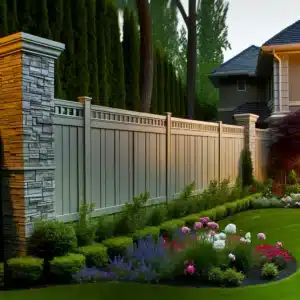In neighborhood life, few things weave together the threads of privacy, property, and politeness quite like a fence. Beyond its wooden slats or chain links lies a complex etiquette, a set of unspoken rules that governs its construction and orientation. It’s an art form passed down through generations, from seasoned hands to eager novices, a blend of common courtesy and practical wisdom that shapes the very landscape of our communities. This blog post delves into the heart of fence etiquette, exploring the age-old question: Who gets the good side of the fence?
The Foundations of Fence Etiquette
The Good Side: More Than Just Aesthetics
At the heart of every fence installation is a decision that might seem trivial to the uninitiated but is loaded with significance: which way should the good side face? The “good side” of a fence, characterized by its smooth and finished appearance, stands in contrast to the side with visible posts and rails, often considered the back. This choice isn’t merely about aesthetics; it’s a statement of respect, a nod to communal living, and a reflection of one’s character.
Historical and Practical Reasons
Traditionally, the good side of the fence faces outwards, towards the neighbors and the street. This practice isn’t just a matter of looking good; it has roots in practicality and respect. Historically, fences were built not just to delineate boundaries but to add to the collective beauty of the neighborhood. Presenting the more polished side of the fence to the world was a gesture of goodwill, a way to contribute to a shared environment that everyone could enjoy.
Moreover, this orientation has practical implications for security and durability. The structure of the fence, with its posts and rails facing inwards, offers a sturdier barrier against the elements and potential intruders. It’s a subtle but effective way to fortify one’s property while still prioritizing the aesthetic value it adds to the communal landscape.
A Metaphor of Craftsmanship and Community
Choosing to give your neighbor the good side of the fence can be likened to the craftsmanship of a skilled artisan who takes pride not just in the functionality of their creation, but in its contribution to the greater whole. It’s about building something that lasts, not just in terms of physical durability, but in the lasting impact it has on neighborly relations. A well-built fence, with its good side generously offered, becomes more than a boundary; it transforms into a bridge, connecting lives and fostering goodwill.
In the grand scheme of things, the orientation of a fence speaks volumes about the builder’s values. It’s a testament to a philosophy that values community over individuality, harmony over discord. As we delve deeper into the nuances of fence etiquette, let’s keep in mind that the choices we make, even in something as seemingly simple as which way a fence faces, can lay the groundwork for the kind of neighborhood we wish to live in.
Read More: Exploring Wooden Fences For California Homes
Navigating Disputes and Finding Common Ground
When the subject of building a new fence comes up, it can sometimes bring neighbors to a crossroads. The key to turning these discussions from potential disputes into opportunities for collaboration lies in the approach. Think of it as akin to laying the foundation for a house; the groundwork of communication needs to be solid, level, and prepared with care.
Starting the Conversation Right
Begin with an open, friendly discussion about the fence project. Invite your neighbor over for a cup of coffee or a casual chat in the yard—whichever setting feels most comfortable and conducive to a relaxed conversation. Present your ideas clearly and listen to their thoughts and concerns with an open mind.
Step-by-Step Guide to Negotiation
- Discuss Placement and Boundaries: Start by agreeing on the exact placement of the fence. Consult property deeds or have a professional survey done if necessary to ensure accuracy.
- Share Design Ideas: Bring several fence designs and styles to the table. Be willing to compromise and find a style that suits both parties’ tastes and needs.
- Talk Costs and Responsibilities: Have an honest conversation about the costs involved and how they will be split. Also, discuss ongoing maintenance responsibilities.
- Plan the Project Together: Decide on a timeline that works for both of you. If hiring a contractor, get quotes together and agree on who will be the point of contact.
Finding Resolution Through Anecdotes
Imagine a scenario where two neighbors are at odds over the height of a new fence. One wants privacy, while the other fears it will block their sunlight. Through negotiation, they agree on a fence that provides privacy at the bottom while incorporating lattice work at the top to allow light to pass through. This compromise not only resolves their dispute but also creates a unique feature that enhances both properties.
Beyond The Fence – Building Community
A fence does indeed mark the boundary of a property, but it should never be a barrier between neighbors. Instead, it can become a symbol of cooperation and mutual respect—a bridge, rather than a divide.
Collaborative Fence Projects
- Joint Planning Sessions: Hold meetings to plan the fence project together, making decisions as a team. This can include design choices, material selection, and scheduling workdays.
- Shared Work Days: Organize days where both parties can contribute labor to the project. It’s a great way to reduce costs and foster a sense of achievement and camaraderie.
- Community Gathering: Once the fence is up, why not celebrate with a small gathering or BBQ? It’s a fantastic way to strengthen bonds and introduce the fence as a joint success story.
Conclusion: The True Value of Sharing The Good Side
In the grand narrative of neighborhood living, the act of choosing who gets the good side of the fence can be a profound gesture of goodwill. It’s a testament to the belief that the most durable structures we can build are not made of wood or metal, but of kindness, understanding, and mutual respect.
This journey through the intricacies of fence etiquette brings us back to a simple yet powerful piece of wisdom: true craftsmanship lies not just in the physical work but in the relationships it helps forge and sustain. As you contemplate your next fence project, remember that its greatest value might not be in the privacy or beauty it adds to your property, but in the peace, friendship, and community spirit it can help cultivate.
Let this be a call to action to approach your next fence project not just with an open mind, but with an open heart. In the spirit of true craftsmanship, let’s build not just fences, but bridges between us, one good side at a time.



